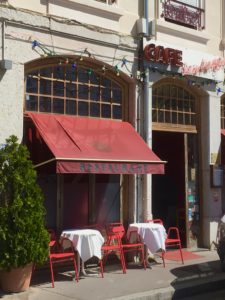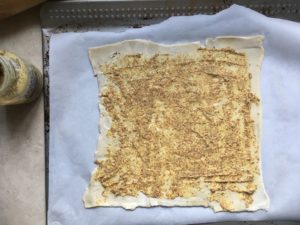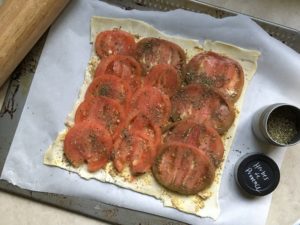
When someone says “French food,” what do you think? Steak-frites? Foie gras? Buttery sauces?
Those things are indeed French. But as I’ve mentioned before, there’s another kind of French food, which you don’t see often in America: simple French home cooking. Unlike the heavy, complicated plates that many American diners perceive as French, these dishes are simple, flavorful, and open to adaptation. To paraphrase Julia Child, this is food that tastes like what it is. When the ingredients are perfect, I think that’s the highest possible praise.
While writing my dissertation in Lyon this summer, I took Sundays off to relax, eat, and explore the city. One Sunday, I decided to treat myself to le brunch–a weekend ritual that is becoming just as popular in France’s major cities as it is in America’s. (So popular, indeed, that not only have the French stolen the noun–le brunch–but they’ve also adapted it into a verb: bruncher.)

I landed at Café des Anges, a homey place with an excellent terrace in Lyon’s 6th arrondissement. The inside of the place was decorated with old rugs, vintage posters, and worn velvet banquettes. The terrace outside was light-filled and quiet. (A deep believer in alfresco dining, I seated myself outside.)


And the food: it was just as homey as the decor. A large buffet featured all of the French home cooking classics that you rarely see in restaurants: simply-done eggplant, a green bean and smoked salmon salad, local charcuterie, and rustic fruit tarts. Needless to say, I worked the sideboard strategically, ultimately taking more plates than I could count and occupying my table for about three hours. It was blissful.


For me, the dish that really stole the show was a simple tomato tart, which was somehow crisp and buttery around the edges but soft and tomato-y (but not soggy) along the interior. After my second slice, I sidled up to open kitchen and asked the chef if he might tell me how it was done. He initially resisted–fair enough–but after finding out I am from California (“Oh la la, j’adorrre San Franceesco!”) he happily spilled the beans.
And it turns out: this could not be any easier. Puff pastry, plenty of dijon mustard, the best tomatoes you can find, seasoning, and a bit of parmesan are all it takes to make le brunch of my dreams.
I recommend serving this with green salad dressed in a mustard-based vinaigrette for a full meal.

Other recipes from a summer in France:
Salade niçoise
Goat cheese toasts with herbed cherry tomato compote
Plum clafoutis
Ratatouille
Salade lyonnaise
Tarte à la tomate
Serves 2 generously
Inspired by the brunch at Café des Anges
Ingredients
17 ounces (490g) frozen puff pastry, slightly defrosted
2 tablespoons Dijon mustard
2 big, farmer’s market tomatoes (see notes), sliced 1/4″ thick
1/2 teaspoon herbes de Provence (or a mixture of dried thyme, rosemary, and/or oregano)
pinch of salt
dusting of parmesan
Instructions
Preheat the oven to 400F (204C).
Place a baking-sheet-sized piece of parchment paper on the counter.
Unroll the puff pastry onto the paper. Using a rolling pin (or a wine bottle, if you don’t have a rolling pin), roll the dough out until it is about 1/8 inch (3mm) thick. My puff pastry came in two rectangles, so I overlapped the two pieces ever so slightly and rolled them out into a single rectangle that measured 9 inches by 10 inches. Don’t fuss too much about size–just make sure the pastry is about 1/8 inch thick. When finished, slide the baking paper and puff pastry onto an unrimmed baking sheet.
Spread the Dijon mustard over the puff pastry in an even, thin layer. Then, add the tomatoes in rows, overlapping each one very slightly. Finally, sprinkle evenly with herbes de Provence, salt, and parmesan.
Place baking sheet with tart in the preheated oven. Bake for 12-13 minutes, or until the tomatoes look cooked but the pastry isn’t too brown.
Remove from oven. Slide the parchment paper and tart onto a cutting board. Slice and serve either warm or room temperature.
Notes
On tomatoes: excuse me while I heave myself up onto my high horse about farmers market versus grocery store tomatoes. The former are just better, simply because it is impossible to produce a tomato durable enough to survive long-distance shipment while retaining flavor. Moreover, for this recipe, grocery store tomatoes’ high water content will produce a soggy tart.
Ideally, then, you should make this with tomatoes from the farmers market. If that isn’t possible, my next recommendation–though I haven’t tested this–would be to make it with sliced grape tomatoes from the grocery store. (If you do that, let me know how it goes!)
Oh my goodness, THIS is the tart! I can’t wait to make it!